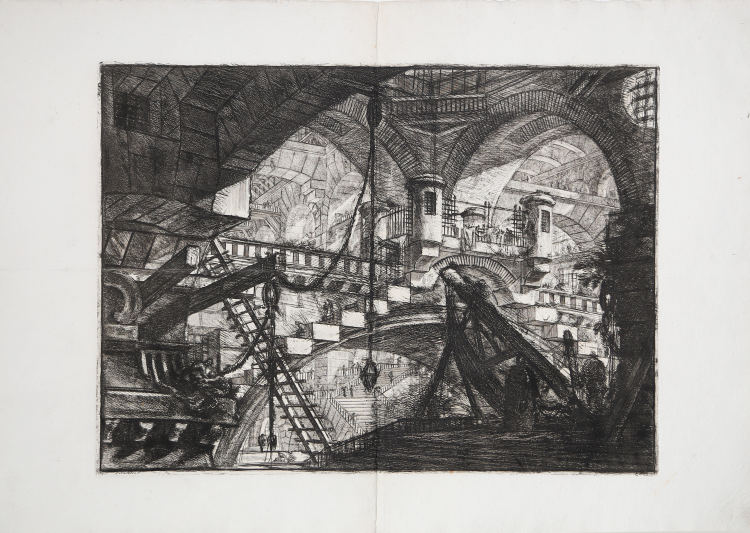



| Reference: | S30498 |
| Author | Giovan Battista PIRANESI |
| Year: | 1750 ca. |
| Measures: | 557 x 408 mm |


| Reference: | S30498 |
| Author | Giovan Battista PIRANESI |
| Year: | 1750 ca. |
| Measures: | 557 x 408 mm |
Etching, engraving, sulphur tint and drypoint, 1750, signed at lower left. From the Carceri set, plate XI of the second edition, second issue.
Example in the fourth or fifth state of six described by Robison, from the contemporary Roman edition (Robison dated to 1760/70).
A magnific impression, printed with black ink on contemporary laid paper, wide margins, usual central fold, otherwise perfect conditions.
Undoubtedly these is the best known and most celebrated series among the works by Piranesi. The series, datable around 1745, consisted of fourteen plates, with the title page bearing the title Invenzioni Capric di Carceri all’acquaforte datte in luce da Giovanni Buzard in Roma, mercante al Corso. In the second issue, immediately subsequent, the title presents the publisher’s name rightly corrected in Bouchard. There is no doubt that the innovative idea of this work comes from a very close connection with the series titled Prima Parte di Architetture not only for the proximity of the dates, but also because both the series reflect the Piranesi’s precise ideology on architecture.
The series was republished after fifteen years, in 1761, extensively revised and corrected. Piranesi was no stranger to revisions and variations on his own works, but it is very interesting to analyse the reason that led him to republish this important work, changing its form. His archaeological experiences in the study that would lead to the Antichità Romane (1756), the controversies with architects and their theories of the period, the awareness that he was still refining his stylistic technique, and the changed architectural concept led him to put his hand to the Carceri. It was with this new and enriched engraving wisdom that the artist went to retrieve the old plates, and after reworking them, he re-presented them in the midst of the polemical figure and ideological struggle regarding architecture that he was conducting in those years. The re-presentation of the series represents a very precise aspect for Piranesi, that is, to re-present, reinforcing it, the polemical message and architectural controversy he had already dealt with years before. The unhinging of spaces and perspective, of logic and all the common principles affirmed in the treatises, a total break with the traditional laws and academic teachings of architecture. Two plates are added in the second edition, which thus includes the frontispiece and fifteen plates. There are notable stylistic differences between the body of the work and the two new plates, where the complexity of structure and architectural composition are remarkable, demonstrating the change that occurred following the archaeological study of the great Roman monuments.
Of a different aspect is the emotional effect aroused by viewing the individual works that make up the series, which, with their melancholic appearance, constitute an element of perennial appeal, inexhaustible vitality, and extreme modernity. The suspension bridges, nets, galleries, staircases and whatever else is present in the Carceri have been the subject of numerous studies, which a copious literature has captured since Romanticism, giving them great popularity and exalting the multiple emotional reactions they conferred.
Magnificent example, from the contemporary second edition, printed on thick paper typically used by Piranesi.
Bibliografia
Andrew Robison, Piranesi: Early Architectural Fantasies: A Catalogue Raisonne of the Etchings, n. 42, IV-V/VI, Arthur M. Hind, Giovanni Battista Piranesi, A critical study (1922), n. 16; H. Focillon, Giovanni Battista Piranesi (1918), n. 39.
Giovan Battista PIRANESI (Mogliano Veneto 1720 - Roma 1778)
|
Italian etcher, engraver, designer, architect, archaeologist and theorist. He is considered one of the supreme exponents of topographical engraving, but his lifelong preoccupation with architecture was fundamental to his art. Although few of his architectural designs were executed, he had a seminal influence on European Neo-classicism through personal contacts with architects, patrons and visiting artists in Rome over the course of nearly four decades. His prolific output of etched plates, which combined remarkable flights of imagination with a strongly practical understanding of ancient Roman technology, fostered a new and lasting perception of antiquity. He was also a designer of festival structures and stage sets, interior decoration and furniture, as well as a restorer of antiquities. The interaction of this rare combination of activities led him to highly original concepts of design, which were advocated in a body of influential theoretical writings. The ultimate legacy of his unique vision of Roman civilization was an imaginative interpretation and re-creation of the past, which inspired writers and poets as much as artists and designers.
|
Giovan Battista PIRANESI (Mogliano Veneto 1720 - Roma 1778)
|
Italian etcher, engraver, designer, architect, archaeologist and theorist. He is considered one of the supreme exponents of topographical engraving, but his lifelong preoccupation with architecture was fundamental to his art. Although few of his architectural designs were executed, he had a seminal influence on European Neo-classicism through personal contacts with architects, patrons and visiting artists in Rome over the course of nearly four decades. His prolific output of etched plates, which combined remarkable flights of imagination with a strongly practical understanding of ancient Roman technology, fostered a new and lasting perception of antiquity. He was also a designer of festival structures and stage sets, interior decoration and furniture, as well as a restorer of antiquities. The interaction of this rare combination of activities led him to highly original concepts of design, which were advocated in a body of influential theoretical writings. The ultimate legacy of his unique vision of Roman civilization was an imaginative interpretation and re-creation of the past, which inspired writers and poets as much as artists and designers.
|